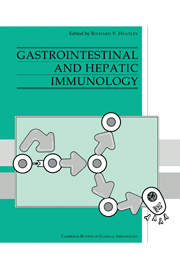Book contents
- Frontmatter
- Contents
- List of contributors
- Preface
- 1 Lymphoid cells and tissues of the gastrointestinal tract
- 2 Lymphocyte migration to the gut mucosa
- 3 Regulating factors affecting gut mucosal defence
- 4 Gastritis
- 5 The immunology of coeliac disease
- 6 Inflammatory bowel disease
- 7 Food intolerance and allergy
- 8 Gastrointestinal and liver involvement in primary immunodeficiency
- 9 Secondary immunodeficiency – the acquired immunodeficiency syndrome (AIDS)
- 10 Intestinal infections
- 11 Lymphomas
- 12 Small bowel transplantation
- 13 Clinical aspects of immunologically mediated intestinal diseases
- 14 Chronic active hepatitis
- 15 Primary biliary cirrhosis
- 16 Immunology and immunopathology of acute viral hepatitis
- 17 Immunology of liver transplantation
- 18 Clinical correlates with hepatic diseases
- Index
8 - Gastrointestinal and liver involvement in primary immunodeficiency
Published online by Cambridge University Press: 03 February 2010
- Frontmatter
- Contents
- List of contributors
- Preface
- 1 Lymphoid cells and tissues of the gastrointestinal tract
- 2 Lymphocyte migration to the gut mucosa
- 3 Regulating factors affecting gut mucosal defence
- 4 Gastritis
- 5 The immunology of coeliac disease
- 6 Inflammatory bowel disease
- 7 Food intolerance and allergy
- 8 Gastrointestinal and liver involvement in primary immunodeficiency
- 9 Secondary immunodeficiency – the acquired immunodeficiency syndrome (AIDS)
- 10 Intestinal infections
- 11 Lymphomas
- 12 Small bowel transplantation
- 13 Clinical aspects of immunologically mediated intestinal diseases
- 14 Chronic active hepatitis
- 15 Primary biliary cirrhosis
- 16 Immunology and immunopathology of acute viral hepatitis
- 17 Immunology of liver transplantation
- 18 Clinical correlates with hepatic diseases
- Index
Summary
The gastrointestinal tract (GIT) is a major component of the immune system. The embryonic gut is important in the development of both humoral and cellular immunity. The thymus and the bursa of Fabricius are involved in T and B lymphocyte differentiation and maturation, respectively. The thymus is derived from the third and fourth pharyngeal pouch. In avian species the bursa is a sac-like structure arising from the cloaca. The human equivalent of the bursa has not been identified but the gut associated lymphoid tissue has been suggested to play a similar role.
The lining of the GIT is an important body surface which interacts with numerous substances including micro-organisms and dietary antigens. Not only are harmful agents excluded by non-immunological mechanisms and by innate immunity, these substances are processed by the adaptive immune mechanisms which enable the body to recognise and to respond to them. Of the cardiac output, 10% goes to the GIT and the portal venous system returns about 20% of the cardiac output via the liver. Together with the lymphatics there is a sizeable traffic of immune cells circulating through the GIT. It is estimated that these cells are capable of synthesising a few grams of immunoglobulins daily.
The GIT is involved in many ways in primary immunodeficiency diseases (PID). It may be the site of presenting symptoms and signs; GIT pathology may complicate PID and 20–25% of patients with common variable immunodeficiency (CVI) have gastrointestinal involvement.
- Type
- Chapter
- Information
- Gastrointestinal and Hepatic Immunology , pp. 169 - 177Publisher: Cambridge University PressPrint publication year: 1994
- 2
- Cited by



